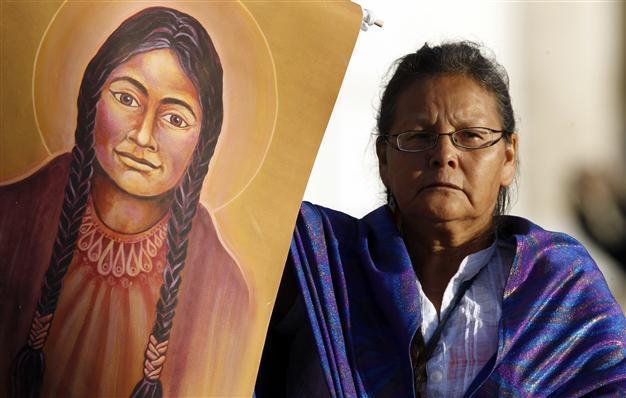Pope names first Native American saint
VATICAN CITY - Agence France-Presse

A faithful holds an image depicting Kateri Tekakwitha, the first ever native American to be declared a saint, before Pope Benedict XVI conducts a special mass to canonize seven new saints including Tekakwitha at St. Peter's square in Vatican City October 21, 2012. REUTERS Photo
Pope Benedict XVI named seven new saints on Sunday, including the first Native American, praising their "heroic courage" as the Catholic Church seeks to counter a rising tide of secularism in the West.
Kateri Tekakwitha, known as "Lily of the Mohawks", who for centuries has been a symbol of hope for the long-oppressed American Indians, was canonised in a lavish ceremony in St Peter's Square that followed her beatification in 1980 by the late pope John Paul II.
Pope Benedict delivered a homily praising all seven new saints, saying they "lived their lives in total consecration to God and in generous service to their brothers".
About 80,000 faithful from numerous countries, including American Indians, gathered on the square outside St. Peter's Basilica, which was decked with portraits of those being canonised.
The other new saints include a French missionary to Madagascar, a young Philippine missionary who died at the age of 17, a German migrant to the United States who took care of lepers and a Spanish nun who campaigned for women's rights.
Vatican watchers said the choice of the saints was linked to the Roman Catholic Church's efforts to highlight the need for a "new evangelisation" as church pews empty in Europe and the United States.
The canonisations were announced during a synod of 262 bishops from around the world.
Tekakwitha, who was born in 1656 to an Algonquin mother and a Mohawk father, was converted by Jesuit missionaries as a child. After being left scarred and partially blind from smallpox and being orphaned, she earned a following for her deep spiritualism before dying at just 24.
Tradition holds that her scars vanished at the time of her death -- considered a miracle that paved the way for her beatification in 1943. Sainthood was assured when the pope certified a second miracle last year, the recovery of an 11-year-old Native American boy from flesh-eating bacteria after his parents prayed for divine intervention through Tekakwitha in 2006.
"She lived a life radiant with faith and purity," the pope said, adding that Tekakwitha should be a symbol of a renewal of faith among indigenous peoples. For a many non-Catholic American Indians, her canonisation is seen as a gesture of reconciliation by the Church for past injustices.
Another figure from North America who became a saint was German-born Franciscan nun Maria Anna Cope, who was born in 1838 and became known as the "Mother Marianne of Molokai" because she looked after lepers on the island of Molokai in the Hawaii archipelago.
In the Philippines, church bells pealed across the country to celebrate the naming of its second saint, young missionary Pedro Calungsod, who was killed at the age of 17 by hostile tribesmen on the island of Guam in 1672 while he was trying to convert locals to the Catholic faith.
He became patron saint for youth after the Vatican recognised a 2003 "miracle" in which a 49-year-old Filipina woman declared dead from a heart attack was revived when a doctor prayed to Calungsod for help.
'He touches the heart of Filipino Catholics' At home, devotees flocked to a small farming town that claims Calungsod as its own, and thousands gathered at venues in the capital of the Catholic country, where the government had set up giant screens to show the proceedings in Rome.
"There is something about him that touches the heart of the Filipino Catholics," Father Francis Lucas, a media officer with the Catholic Bishops Conference of the Philippines, told AFP.
A French Jesuit, Jacques Berthieu, who was executed in 1896 in Madagascar by rebels from the Menalamba movement, was also canonised.
The missionary refused to renounce his faith and is considered the first saint of Madagascar, where he lived for 21 years.
A German lay woman, Anna Schaeffer, who was from the pope's German home state of Bavaria, was also rewarded by the pope.
Schaeffer, who died in 1925, was badly burnt after falling into boiling water and spent the rest of her life bedridden.
She is credited with spreading the word of God in local villages.
An Italian priest, Giovanni Battista Piamarta, who in the late 19th century devoted his life to helping young people during the industrial revolution and founded a religious congregation, was also canonised.
The seventh new saint, Spanish nun Maria del Carmen, also founded a congregation and worked to better the lot of poor women in the 19th century, defending their social rights and helping their children's education.
The new canonisations bring to 44 the number of saints named by the pope since the start of his pontificate in 2005.
Catholic saints have to have two miracles to their names, which must be certified by the Vatican in a years-long procedure.
